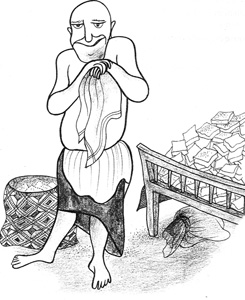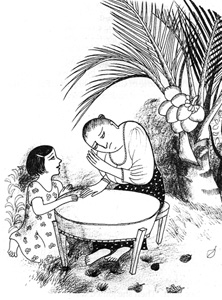Where are the
Grown-ups?
Where are they?
They have all
Become children.
It's New Year’s
Day
Preparations for the celebrations of the Sinhala New Year in April began months ahead. And we kids had a great time participating in all the activities in our own special way.
Grown-ups in our village always had children in mind, in whatever they did. I suppose that was the reason why they started off by putting up the swing first. And for this, rope was home made, strong and tightly twisted to ensure the safety of the young ones.
From the time the swing went up on the mango tree, it was New Year celebrations for the kids, who more or less lived on the swing.
Before making the sweetmeats, coconut oil had to be made. For this our immediate neighbours gathered together at Attamma's centre hall.
The huge basin from under her massive bed was dragged out, washed thoroughly and cleaned. Then the women sat on several coconut scrapers around this huge basin, scraping coconut. A big heap of coconuts were cracked and the coconut water was the kids’ delight. We drank and drank the water till our bellies bloated out like ballons. Then we kept jumping up and down to hear the water gurgling in our tummies. Nobody stopped us doing this. Nobody cared.
Lunch for everyone present on that day was cooked in our kitchen. It was a very simple meal consisting of coconut sambol, rice and a dried fish curry.
The grown-ups scraped coconuts during the entire morning, talking laughing and cracking jokes. After lunch, extracting coconut milk began. All the hands were in the big basin with the scraped coconut, squeezing to extract the milk.
The highlight of the day was when the temporary hearth was put together in a corner of the compound. The big cauldron from under Attamma's bed was pulled out. Into this was poured the extracted coconut milk. And then each one took turns to stir the boiling milk. They stirred till the sun turned westwards.
After some time the oil appeared on the surface, which was gently skimmed and stored in a big jar.
And what happened to the coconut refuse? Certainly it was not thrown away. Attamma knew just what the kids relished. So she put honey into the cauldron and mixed the left over contents well. And that became a delicious pudding you ever did taste. Attamma brought dishes filled with this most wonderful thing right into our playhouse. The name for this sweet dish was kirijje. For generations children have eaten this sweet pudding, said my mother.
Usually on New Year's eve mother and Caroline had much to do. They cleaned and removed ash from the hearth. Astrologers prescribed a time to stop work for the old year, on New Year's eve. Until the dawn of the New Year it was Nonagathe, the time to devote to religious activities. During the Nonagathe no work should be done. The hearth should not be lit. Lighting the hearth for the New Year is done at an auspicious time prescribed by astrologers.
Everyone went to the temple during Nonagathe. We too joined our neighbours, all dressed in white carrying flowers, joss sticks, coconut oil and wicks for the oil lamps. We worshipped at the dagoba, shrine room and across the road at the old Bo tree. On returning home mother spread mats under the mango tree and we spent our time in joyous mood playing indoor games like Punchi.
Punchi is played with five small sea shells, a coconut shell and a chart. Players are divided into two groups. My father and I were always on one side, while mother and Caroline were on the opposite side.
Half way through the game, father would whisper to me, "We should let them win. If mother loses, she will be angry and getting angry on New Year's day is not very good."
Then came the best treat for me in a way. It was a bundle of fire crackers to be lit at the dawn of the New Year.
Attamma had brought out her big rabana, the large tambourine, propped up on three wooden legs.
Before beating a tune with her fingers on the rabana, Attamma heated it over burning coals to make the tune clearer when playing on it.
Mother and Caroline were in the kitchen with everything ready for the making of kiribath, waiting for the auspicious time to light the hearth.
When the temple bells pealed, a burst of fire crackers filled the air. From far and near came the rhythmic beat of the rabana playing.
Kitchen hearths must have been lit in every home. My mother lit the hearth and placed the pot of rice on it. Then she joined her hands in worship according to custom. Soon the orange flames danced. The new pot on the fire was slowly getting black.
A smile on Caroline's face appeared and disappeared as she cracked a coconut and began to scrape.
The coconut milk extracted, Caroline waited for the rice to cook.
Out in the yard Attamma was beating a popular tune on her rabana. Calling me to her side Attamma taught me a popular beat to play.
'Punchi batala getatumba kola
Linda watakara bahina batala.'
While she beat out complicated tunes I played the accompaniments.
Finally the smell of kiribath came swirling out of every kitchen in the neighbourhood bringing with it the spirit of a happy New Year.
Our dining room became charmingly alive. A pure white cloth was laid on the table. On it was placed the small brass lamp, polished for the occasion with new wicks and oil ready for lighting at the auspicious time before partaking of the first meal of the New Year. Mother brought in the big tray of kiribath cut into diamond shapes, and placed it in the centre of the table. The various types of sweetmeets were arranged around the tray of kiribath. There were kevun, asme, athirasa, kokis and aluwa and also a luscious comb of golden yellow bananas.
Just a little before the appointed time to partake of the first meal of the New Year, father lit the lamp and kindled a handful of joss sticks placing them in a little jar on the window sill. The smoke carrying the smell of burning incense went curling around creating an aura of divine sanctity.
Mother dished out platefuls of the meal for everyone and we waited for the auspicious time to eat. The first meal for the New Year had to be taken facing a certain direction prescribed by astrologers each year.
Once again the temple bells pealed and then it was time to begin the meal. Mother handed father his plate of food and ours were given in turn.
Our dog 'White' dashed into the house and crept under the string bed in the dining room afraid of the fire crackers bursting outside. 'White' was also given his New Year feed which he lapped up from under the bed.
There was a most peculiar thing that intrigued me in this whole ceremony. Before we began to eat our food, each one of us had to pick out a bit of every item of food on our plate and drop it into a piece of banana leaf. This was taken outside the house and placed on a high elevation away from cats and dogs.
I asked my father for whom this food was meant to be. He told me it was for the unseen ones, the spirits of the dead. I was unable to understand how the dead could turn into spirits and still lurk around. But all I saw was that the birds and squirrels too had a feast as well on New Year's day, which I thought was a wonderful thing.
After the New Year meal mother worshipped father offering him a sheaf of betel leaves. We too offered betel to father and mother, worshipping them. The elders in the village were always offered betel in this way on New Year's day.
Father gave each one of us a silver rupee coin blessing us with good health, happiness and prosperity.
Many people came visiting my mother on New year's day, mainly to receive a silver coin from her as the first transaction of the New Year. They believed she was a generous lady. The people came with platefuls of kiribath and sweetmeats and all this fare was heaped on the string bed which had a mat on it, in our dining room.
My mother gifted this huge mound of eatables to Saibu Nana, a helper of the village. That day Saibu Nana was like a pendulum of a clock, going to and fro from our home to his, transporting bagfuls of kiribath and sundries balanced on his head. If there was a competition on that day for the happiest face in the village, Saibu Nana's face would definitely have been the winner!
The old and the young played together on New Year's day. Some played the cadju nut game on the gravel road. Some sat in groups on the verandahs playing punchi. The men folk indulged in playing draughts and card games.
We kids had a rollicking time on the swing. The swing had a long plank on which sat all the kids holding each other firmly. On either side stood two young women who swung forwards in turn. As the swing moved to and fro, the women worked up the speed by pushing themselves forward in mid air. Soon the swing went flying high, while the women sang long drawn swing songs.
|


